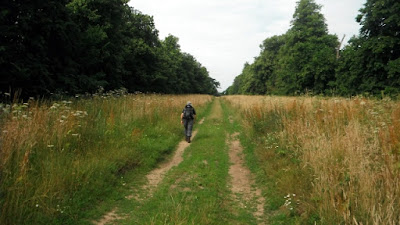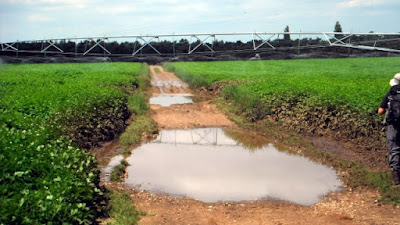BARROW'S CORNER TO THETFORD
Summary - There was only 7 miles left to do so after an early start we were back in Thetford for lunch. This last section was also part of the St Edmund Way and mainly ancient track ways to start with and finishing across Barnhamcross Common.
Because we only had four miles to drive to the start of the walk we were started on the Angles Way before nine in the morning. After parking near the B1106 it was back along yesterdays track passing the cottages and the pig farm to Barrow's Corner. There had been thunderstorms overnight so there were large puddles to avoid. The route in to Thetford was also part of the St Edmund Way and once again it was farm tracks with fields to the right and Albemarle Plantation on the left followed by Sandgault Plantation after that.
There were footprints of deer in the mud but we did not see any.
After crossing the Elveden Road the track continued with rough grassland on the right and Marmansgrave Wood on the left within which there was a herd of black sheep wet and no doubt thankful the eventful night was over.
The St Edmund Way is waymarked with these signs. A route across Suffolk, using the Stour Valley Path (East Anglia) to Sudbury and Long Melford and then going via Lavenham and Little Welnetham to Bury St Edmunds, burial place of the martyr King Edmund slain by the Danes in 869, along the waymarked Lark Valley Path (13 miles and included on OS mapping) to the Icknield Way Path at West Stow before striking over the Brecks to Thetford and the Hereward Way. Extract from https://www.ldwa.org.uk/ldp/members/show_path.php?path_name=St+Edmund+Way
Initially our way was north but then it turns east through woods to traverse Barnhamcross Common which is dissected by the Bury Road. It was here that we encountered our only problem on the route. At the point on the Ordnance Survey maps and the Norfolk County Council on-line maps show the Angles Way crossing the Bury Road some kind soul had dug deep trenches on both sides no doubt to keep vehicles off the Common. We crossed one to get onto the road but the ditch on the east side was too perilous to contemplate. We walked south along the Bury Road to a car park where we able to cross to the east side of the Common. We used the path up the east side to get to the urban edge of Thetford.
We could not find a point marking the end so we used the Nunnery Arch as our "end".
"The red-brick gateway which marked the entrance to the Place Farm or Nunnery at Thetford, is blocked by a wall and it is stated that this was built up seven times, and knocked down seven times by a carriage with four horses" (TL873823). My photo dates from the 1970s - the gateway is no longer blocked up nowadays. Extract from http://www.hiddenea.com/norfolkt.htm
We continued down the hill to the Nun's Bridge over the Little Ouse River which we followed through Thetford back to the Premier Inn (our base for five nights) for lunch in the Warrener Public House next door. This has a good value three course meal each day as well as a normal pub menu and is recommended.
On the way along the river we came across this statue of Captain Mainwaring from Dad's Army which was filmed in Thetford and there is even a museum http://www.dadsarmythetford.org.uk
In the picture is Jim who was my reliable companion on this trip.























































